by admin | May 8, 2018 | Blog, Breweries, Local Beer
Meet the Brewers is an ongoing series to highlight the individuals who make the beer at our Wilmington breweries. Check back every week to see the latest interview. All photographs provided by Brian Lantz Photography. Check out his instagram at @brianlantzphotography
Christopher McGarvey is the Brewmaster at Front Street Brewery whose journey with beer started homebrewing soda in college and has led him Front Street Brewery Brewmaster.
Where are you from?
East Peoria, IL
What first got you into brewing?
My college roommate and I decided we wanted to try making our own ginger beer soda because we were adventurous cooks. We bottled it in re-used IBC root beer bottles with corks, which proceeded to fire off spontaneously in the night with a loud bang as the bottles carbonated. I drank one of the open bottles I found the next day and got food poisoning for three days. So I guess that complete failure incited my stubborn perfectionist spirit, and I set out determined to get it right, but with beer, where no pathogenic microbes can live.
How long have you been brewing?
I started homebrewing in 2005 and quickly devoured every book on the subject. I used to sneak onto the Northern Brewer discussion forum during a summer internship in the engineering department at Nelson Sprinkler Company for hours at a time, and a lot of my early ideas came from exchanges there. I became an assistant brewer at FSB in 2011, and brewmaster in summer 2016.
What was the first beer you made?
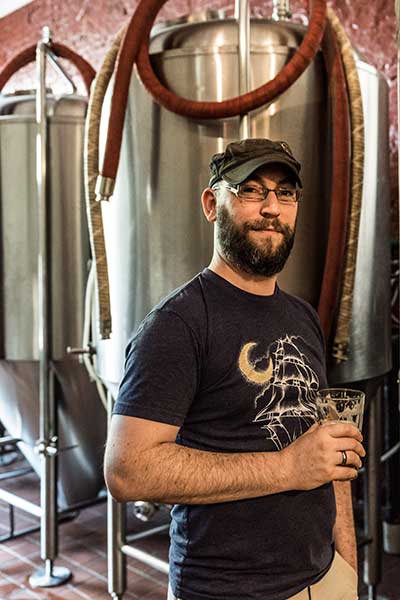
The first recipe I concocted myself was a clone recipe of Samuel Smith’s Oatmeal Stout. The first beer I made as a professional brewer was Tomb Rocker, my special honey and heather Scotch ale that I’ve brewed every year since 2007 for Easter in the Orthodox Church.
What is your favorite beer to make?
I consider Tomb Rocker to be my magnum opus. There is no other beer like it in the world. If I were a monk, this would by my Trappist ale. It drinks almost more like a fine port than a beer, with layers and layers of complexity and a grapey, vinous tang, plus the cool, slightly minty flavor of Scottish heather flowers. It has won over a lot of people who thought that they would never like a beer at all, and they try it and find that they love it. And now that we are brewing it at Front Street Brewery every spring, we have my priest and my choir come in and sing and pray, and
we bless the beer with holy water for the joyful time of the church year. All that said, it’s a real pain to make, a really long, tedious brew day. So probably my favorite to actually brew is our English bitter, which smells wonderful in the mash.
What made you want to start brewing on a larger scale?
Not to sound too cheesy, but something like divine providence. I had no plans or ambitions to be a professional brewer, but when I graduated from seminary in 2010, my classmate Fr Peter Robichau convinced me to move here and be choir director for St. Basil Orthodox Church. I went to Front Street Brewery because I like good beer and it was the only show in town, and I ended up becoming friends, then roommates with the brewmaster, Kevin Kozak. I needed a job really bad and he got me one working at the host stand, where I was almost a decade older than everyone else. Eventually, I won the FSB homebrew competition and became the natural replacement as Kevin’s assistant brewer when the former one moved out to Hollywood. So I’m an accidental pro brewer, and I consider myself very blessed and very lucky to be able to do it for a living.
Is there anything you do differently in your brewing process that other places do not do?
Well, I’m pretty sure we’re the only brewery in town using holy water. Besides that, I hope people will recognize the finesse and nuance that we’re crafting into every pint we produce. It takes incredible patience and persistence to fine-tune the beers the way we have. We do an in-depth sensory analysis of every single batch of beer we brew, as well as blind tastings of our beers against the best examples in the style. And we tweak our recipe a little each time until we get it perfect. We’re about a year and a half into a revision of all our recipes, and many of them are on the 14th or 15th version. It’s really starting to pay off. But we won’t be done until they’re our perfect favorites in a blind tasting, and when that happens, we’ll do a big public reveal of Front Street Brewery 2.0!
What is one thing you want your consumer to take away after trying your beer?
A growler. Haha. Our philosophy here is completely dedicated to harmony, balance, and drinkability, whether that’s in a pilsner, an IPA, or a crazy experimental beer. If we’re doing our job right, you’re going to find yourself with an empty glass before you know it, and you’re going to want another. To me the sign of a truly great beer isn’t how much it bowls you over on the first sip, but how surprised you are to find yourself at the bottom of the glass. Where did it go? I need more. That’s a great beer.
by admin | Apr 17, 2018 | Blog, Breweries, Community, Local Beer
Meet the Brewers is an ongoing series to highlight the individuals who make the beer at our Wilmington breweries. Check back every week to see the latest interview. All photographs provided by Brian Lantz Photography. Check out his instagram at @brianlantzphotography
Kevin Zelnio is the head brewer at Wrightsville Beach Brewery. Zelnio began brewing while living in Sweden and eventually brought his talents back to Wilmington, NC. Last week I asked him what his journey into brewing was like.
Where are you from?
Born and raised where the Mississippi flows east to west in the Quad Cities, mostly on the Iowa side.
What first got you into brewing?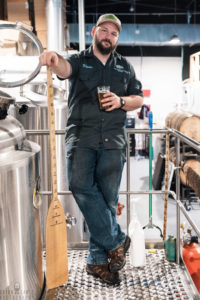
A good friend of mine started to dabble in home brewing and I joined in a couple times. But I didn’t really get into it until I moved to Sweden several years ago and lived out in the woods. I was working from home as a science writer and consultant and had a bit of time on my hands. Beer is also pretty expensive there and controlled by a state-run alcohol monopoly, so the nearest place I could get a beer was a 45-minute drive away. It became more of a practical thing for me, as well as a creative outlet!
How long have you been brewing?
This is my sixth year as a commercial brewer.
What was the first beer you made?
With my aforementioned buddy we did a green tea pale ale with tettnang and cascade hops and green tea we bought from a market in Japan while at a deep-sea biology conference (my former life was a marine biologist). The first all grain brew I did on my own was a Sierra Nevada Pale Ale clone.
What is your favorite beer to make?
Stouts and porters. Nothing makes me happier than filling up the brewery with the smells of mashing in dark grains early in the morning!
What made you want to start brewing on a larger scale?
While in Sweden, I lived in a small village and our neighbors there enjoyed the free beer I was constantly giving to them. They encouraged me to start selling it. After raising the money, I selected a location in an old prison that was turned into a hotel in the small Baltic town of Västervik. Bryggeri Fängelset (literally meaning “The Prison Brewery”) was a small 3 barrel capacity brewery that I solely ran with my wife and business partners for almost 3 years.
Having honed the creative skill set and brewing process, my wife and I decided we could have better opportunities back home in the US. After suffering the cold north for far longer than I needed to, I landed a great job as a production brewer at Jdub’s Brewery in Sarasota, Florida. There, I got comfortable with large tanks and big machinery and learned the skills and techniques for high volume production brewing that I currently use now as the Director of Brewing Operations at Wrightsville Beach Brewery. Brewing on a 20 barrel capacity gives me the leeway and creativity I crave in a career while working with an amazing, supportive team. There is truly nothing better than making a product that people really enjoy.
Is there anything you do differently in your brewing process that other places do not do?
Every brewery has their niches and strengths. I love having the freedom to experiment with ingredients, like fruits and herbs, in the brewing process and playing around with barrels. It starts from the water — where I build up each batch’s water mineral profile from the ground up— to the final product where we measure parameters, dial in carbonation and monitor the quality of the fermentation and packaging processes at every step.
What is one thing you want your consumer to take away from trying your beer?
The most important thing to me is that I brew up a wide diversity of styles and offerings. I don’t expect everyone that walks in to love every single brew I make, but hopefully they find a few very enjoyable and want to come back to see what is new. I am proud of every beer we put out and we always strive for the best quality possible in our products. I think it shows and I hope our customers notice it too!
by admin | Apr 11, 2018 | Blog, Breweries, Community, Local Beer
Meet the Brewers is an ongoing series to highlight the individuals who make the beer at our Wilmington breweries. Check back every week to see the latest interview. All photographs provided by Brian Lantz Photography. Check out his instagram at @brianlantzphotography
Blair Ferguson is the head brewer at Wilmington Brewing Company. Brewing was a hobby for a large portion of Ferguson’s life before he decided to begin brewing professionally. Recently I asked Ferguson about his favorite beer to make.
Where are you from?
Winston-Salem, NC .I attended Mineral Springs Elementary School. Go Bulldogs!
What first got you into brewing?
I’ve always liked to make things. I discovered home brewing when my interests turned to beer in college.
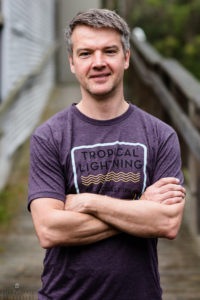
All photographs provided by Brian Lantz Photography. IG: @brianlantzphotography
I had to give it a shot. It was fun to make different beers and share cheer with friends. It still is.
How long have you been brewing?
As a hobby, off and on as life allowed for around twenty years. I have been brewing professionally since 2014.
What was the first beer you made?
My first brew was an American pale ale. Luckily, it was drinkable and I continued brewing. American pale ale was really the first beer style to showcase the amazing aromas and flavor of American hops. I think it inspired a lot of brewers and its influence continues as evidenced by the popularity of IPAs today.
What is your favorite beer to make?
I really like making new beers. Getting creative with recipe formulation and seeing how it turns out is gratifying. Fortunately, we live during an exciting time for beer. Consumers are receptive to trying new and different brews. Craft beer is a great marriage of tradition and innovation.
What made you want to start brewing on a larger scale?
I wanted to make a living doing something I love.
Is there anything you do differently in your brewing process that other places do not do?
At its heart, brewing is a traditional industry. So a lot of processes are similar. That said, we are a very quality focused brewery and are always open to tweaking our process to ensure the best product we can make. If we discover a method that makes better beer, we will use it.
What is one thing you want your consumer to take away after trying your beer?
Hopefully, our beer sets the stage for healthy conviviality. A great sensory experience from tasting a fresh product made with care should enhance the moment.
by admin | Apr 2, 2018 | Breweries, Community, Local Beer
Meet the Brewers is an ongoing series to highlight the individuals who make the beer at our Wilmington breweries. Check back every week to see the latest interview. All photographs provided by Brian Lantz Photography. Check out his instagram at @brianlantzphotography
Dani Bearss is the head brewer at Waterline Brewing Company. A self-described nomad, she has traveled all over but settled down in Wilmington to bring us great beer. Recently I asked Bearss about her journey to head brewer.
Where are you from?
Originally I’m from Michigan, but I’ve always been a nomad. I’ve spent time living all over California as well and I just returned to Wilmington after spending a year in New Zealand, first hiking the 3000 km Te Araroa trail then working as a brewer.
What first got you into brewing?
I used to work as a barista in a competition cafe, and when I learned about the craft beer movement, it was a natural transition between roasted beans and malted barley. I was living in the land of Founders, New Holland and Bells, all of which were less than an hour away, and I knew a few of the people making beer professionally. I liked the combination of art, science and manual labor…when I saw the process commercially, I was hooked.
Waterline gave me my start into brewing when they were just as new to Wilmington 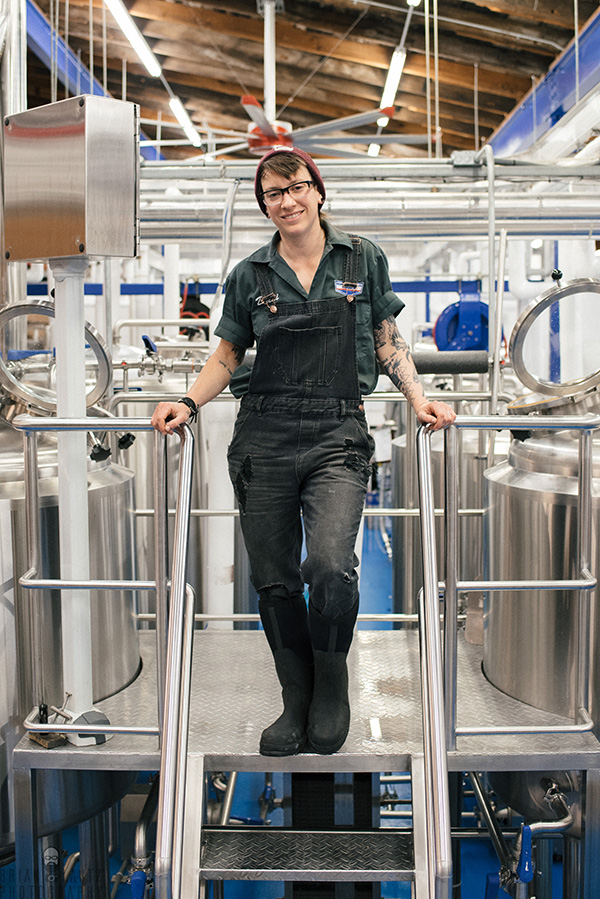 as I was, and for a while, I was just a part-time bartender and over-eager volunteer to clean kegs and squeegee the floor. Brian (Waterline’s former head brewer and part owner) saw how eager I was to learn and gave me every opportunity to move up as long as I was willing to work for it.
as I was, and for a while, I was just a part-time bartender and over-eager volunteer to clean kegs and squeegee the floor. Brian (Waterline’s former head brewer and part owner) saw how eager I was to learn and gave me every opportunity to move up as long as I was willing to work for it.
How long have you been brewing?
I started brewing with my friend back in Michigan maybe only five or six years ago and started brewing professionally a few years later when I got connected with Waterline. I’ve been a volunteer, a cellar(wo)man, and an assistant brewer with my own commercial beers at Waterline, and in New Zealand, I was a lead brewer for Renaissance Brewing. I returned to Wilmington and Waterline a few months ago to take on the Head Brewer position.
What was the first beer you made?
I think the first thing I made back in Michigan was a raspberry stout, one of my friends’ recipes. The first all grain beer I ever concocted on my own was my “Port City Paradox,” a coffee porter that was both beer AND coffee–I brewed the coffee using beer as the solution instead of water. I wanted to combine my two favorite vices: coffee and beer. Delicious! And impossible to carbonate.
What is your favorite beer to make?
I still get a rush anytime I get to brew a beer that I designed from start to finish–I think it’s a homebrewer’s curse that I’ll never get over, the fact that I have a beer on tap and people order it. I’ve been really excited to bring back what I learned in New Zealand and introduce some beers made with lesser known NZ hops, like our XPA, and while it will always terrify me just a little, I love taking the plunge into brewing any new beer on a commercial scale.
What made you want to start brewing on a larger scale?
I like the mental and physical challenge of large-scale brewing. There are always new recipes and better ways to do things, and there’s a lot of science, but it’s a lot of moving hoses and kegs and lifting bags of grain and being on your feet all day. I’ve logged nearly 3000 miles of backcountry hiking, and before I was ever into coffee and beer I worked with horses for a long time, working with professional teams and training sport horses. There is something about the long hours, manual labor, and teamwork that calls to me.
Is there anything you do differently in your brewing process that other places do not do?
I think we all have our little brewery quirks, and it’s part of what makes the independent beer community so diverse. Since coming back to Waterline, I’ve been starting to incorporate some of the techniques we used in New Zealand to produce low-gravity, flavor-packed beers that are easy to drink. I like to make unexpected beers that go against the current trends, like the seasonal Gruit and the “new New” XPA, a low alcohol, crystal clear and super smashable New Zealand (“not New England!”) style pale ale.
What is one thing you want your consumer to take away from trying your beer?
I always aim to please through something unexpected, whether it’s something people have never had or something they thought they had discounted in the past. I strongly believe that you have to know the rules in order to break the rules, and I try to balance the “weird beers” with classic recipes when thinking about new beer. We have the Roma Gose, the Coffee and Cream and the Gruit that were a lot of fun to come up with, but I also enjoy designing more traditional beers such as the Wee Heavy, the Porter and the new “Extra” Pale. I hope consumers can always come to Waterline for a selection of traditional styles and experimental flavors.
by admin | Mar 27, 2018 | Blog, Breweries
Meet the Brewers is an ongoing series to highlight the individuals who make the beer at our Wilmington breweries. Check back every week to see the latest interview. All photographs provided by Brian Lantz Photography. Check out his instagram at @brianlantzphotography
Dean Kelley is the head brewer and Co-owner at Salty Turtle Beer Company. Kelley has been brewing beer since he made a brown ale from a kit in 2014. Recently I asked him about his brewing journey.
Where are you from?
I grew up in Massillon, Ohio. When I graduated High school, I joined the Marine Corps and was stationed at Camp Lejeune from
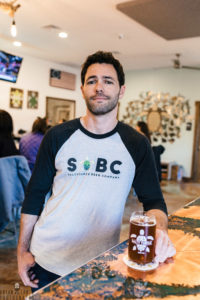
2005 until I got out in 2013. Have stayed in the area since.
What first got you into brewing?
I was overseas for a security contract and got into reading a brewing magazine I found one day. When I got home from the contract I decided that I wanted to try brewing and ordered my first kit and equipment.
What is your favorite beer to make?
I like making all different styles but if I had to pick one I would say saison.
What made you want to start brewing on a larger scale?
I always thought it would be great to own my own business one day. It was always a dream until I meet one of my neighbors (Dan) while at his yard sale and realized he had the same passion. So, after that, myself and Dan pushed to make our dream a reality.
Is there anything you do differently in your brewing process that other places do not do?
I would say the process is pretty standard. The only odd thing is how Frankenstein-ed the system is. We are using a dairy tank for a mash tun and a HLT I welded up.
What is one thing you want your consumer to take away after trying your beer?
I want people to try things outside their comfort zone and not be deterred by the style or color. I am sure they will find something they like. And we always want to provide the customers with a great tasting product.

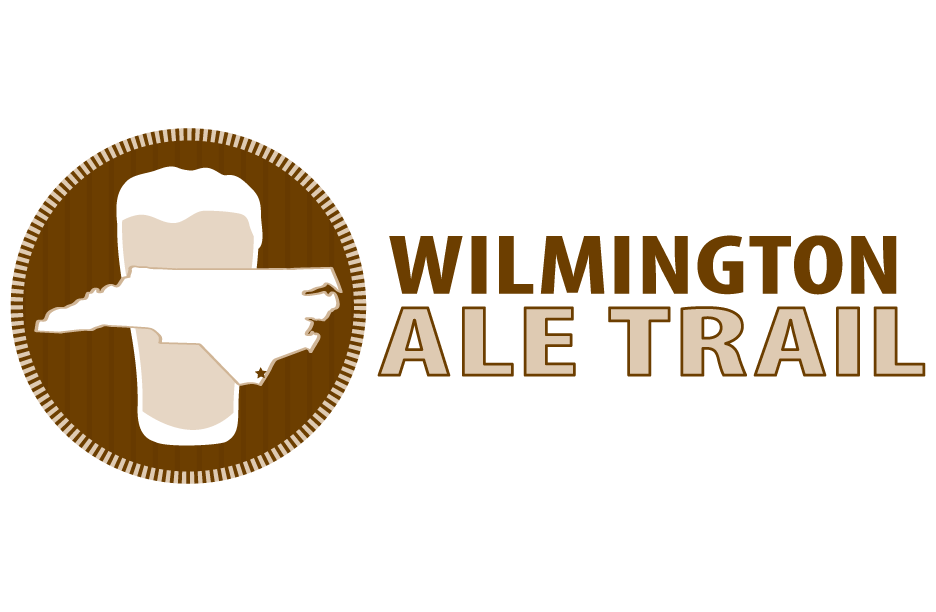


 as I was, and for a while, I was just a part-time bartender and over-eager volunteer to clean kegs and squeegee the floor. Brian (Waterline’s former head brewer and part owner) saw how eager I was to learn and gave me every opportunity to move up as long as I was willing to work for it.
as I was, and for a while, I was just a part-time bartender and over-eager volunteer to clean kegs and squeegee the floor. Brian (Waterline’s former head brewer and part owner) saw how eager I was to learn and gave me every opportunity to move up as long as I was willing to work for it.
